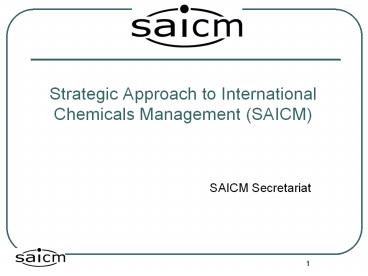Strategic Approach to International Chemicals Management (SAICM) - PowerPoint PPT Presentation
Title: Strategic Approach to International Chemicals Management (SAICM)
1
Strategic Approach to International Chemicals
Management (SAICM)
- SAICM Secretariat
2
What is SAICM ?
- SAICM is an international non-binding policy
framework to support efforts to achieve the
Johannesburg Plan of Implementation (WSSD) goal
for chemicals, notably - achieve by 2020 that chemicals are used
produced in ways that lead to the minimization of
adverse effects on human health the
environment - Adopted by Ministers, Heads of delegation
representatives of civil society private sector
at International Conference on Chemicals
Management (Dubai, 2006)
3
Key Characteristics of SAICM
- An international voluntary and non-binding policy
approach for chemical safety. - Global approach which covers all agricultural and
industrial chemicals throughout their life cycle.
- Recognizes the gaps needs of developing
countries and countries in economic transition,
particularly in relation to capacity-building. - Reflects environmental, economic, social, health
and labour aspects of chemical safety. - A pro-active, inclusive and overarching platform
for engagement and commitment of governments, key
inter-governmental organizations (IGOs),
non-governmental organizations (NGOs) and
industry. - Aims to coordinate, catalyze and facilitate
actions.
4
The core SAICM texts resolutions
- Dubai Declaration
- The political commitment
- Overarching Policy Statement
- Setting out scope, statement of needs,
objectives, financial considerations, principles
approaches, modalities for implementation
reviewing progress - Global Plan of Action
- Identifies work areas activities to achieve the
2020 goal, including for nanotechnology - Resolutions adopted by the ICCM
5
The ICCM - Governing Body of SAICM
- ICCM International Conference on Chemicals
Management - ICCM4 is scheduled in Geneva from 28 Sept to 2
Oct 2015 - Comprising governmental, non-governmental and
intergovernmental stakeholders - Undertakes periodic reviews of implementation and
convenes triennially (2006, 2009, 2012, 2015 and
2020).
6
Key decisions / outcomes expected at ICCM4
- Agreement on the Overall Orientation and Guidance
towards the achievement of the 2020 goal a key
strategic policy piece - Decision on a Chemicals in Products Programme
- Consideration of proposed elements of a draft
resolution on nanotechnology - Decision on the emerging policy issue proposal
for Environmentally Persistent Pharmaceutical
Pollutants - Consideration of a Highly Hazardous Pesticide
(HHP) proposal - Discussion on sound management of chemicals
beyond 2020 - Consideration of Sustainable Development Goals
and discussion of the Strategic Approach
contribution to implementation. - Decision on activities and budget of the
secretariat, and decision for closure of the QSP
Trust Fund
7
SAICM and emerging policy issues
- One of the functions of the ICCM is to focus
attention and call for appropriate action on
emerging policy issues as they arise and to forge
consensus on priorities for cooperative action
(para 24 (j) of the Overarching Policy Strategy). - SAICM facilitates actions and provides a
multi-stakeholder an multi-sectoral forum on
emerging policy issues.
8
SAICM Emerging policy issues
- Lead in Paint
- Chemicals in Products
- Hazardous substance within the life cycle of
electrical and electronic products - Nanotechnology and manufactured nanomaterials
- Endocrine-disrupting chemicals
- Environmentally Persistent Pharmaceutical
Pollutants (EPPP) proposed as an emerging policy
issue for consideration at ICCM4.
9
Emerging policy issues at ICCM4
- Workplans under development by emerging policy
issue leads and will be available for
consideration by participants at ICCM4. - Encouraging continued and enhanced actions on
emerging policy issues through the Overall
Orientation and Guidance towards the achievement
of the 2020 goal. - Regarding Nanotechnology
- OEWG2 adopted elements of a draft resolution on
nanotechnology for consideration of ICCM4.
10
Nano resolution at ICCM4
- Key elements for a draft resolution on
nanotechnologies and nanomaterials for
consideration by the International Conference on
Chemicals Management at its fourth session - Reaffirms resolutions II/4 E and III/2 E on nano
- Special emphasis to
- facilitating the exchange of information
possible SAICM clearing house - developing international technical and regulatory
guidance and training materials - welcoming the work of the UN sub-committee on GHS
and nano
11
Nano resolution at ICCM4
- Key elements for a draft resolution on
nanotechnologies and nanomaterials for
consideration by the International Conference on
Chemicals Management at its fourth session - Invites all stakeholders to continue raising
awareness and enhance capacity, for example
e-learning courses and regional consultation - Encourages SAICM stakeholders to use the nano
guidance document - Requests continued engagement of all SAICM
stakeholders, including IOMC organizations - Invites all SACIM, as appropriate, to provide
resources.
12
Keys to achieving SAICM implementation
- Involvement of all stakeholders Government,
non-governmental and intergovernmental - High-level commitment from all sectors health,
environment, industry, labour, economic - Emphasis on the sound management of chemicals as
a sustainable development issue - Implementation depends on actions at national,
regional and international levels - Early enabling actions - to build necessary
capacity relevant stakeholder participation
13
For More Information
Please visit the SAICM web site
at www.saicm.org Contact Secretariat for the
Strategic Approach to International Chemicals
Management (SAICM) c/o Chemicals Branch,
UNEP/DTIE 11-13 chemin des Anémones CH-1219
Châtelaine, Geneva Switzerland Tel (41 22) 917
8532 Fax (41 22) 797 34 60 Email
saicm.chemicals_at_unep.org
13































